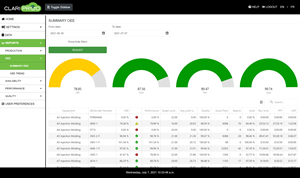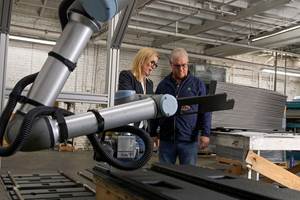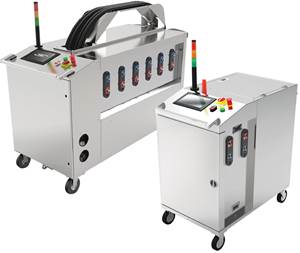Processing Megatrends Drive New Product Developments at NPE2024
It’s all about sustainability and the circular economy, and it will be on display in Orlando across all the major processes. But there will be plenty to see in automation, AI and machine learning as well.
NPE2024, the Plastics Show, could just as easily have been tagged NPE2024: the Plastics Sustainability Show. Across the spectrum of processes, attendees walking the floors of the Orange County Convention Center (OCC), Orlando, Florida, May 6-10, will bear witness to new products that reflect the industry’s need to be part of the circular economy. On the pages that follow this intro, you will notice technology introductions that consume less energy, take up less space, run more environmentally conscious materials, and then some.
While we preview the three major processes here, sustainability is also making its mark on the development of new materials (see Close-Up p. xx) and in the way OEMs and brand owners are thinking about plastics (see Close-Up p. xx).
All that said, there will also be plenty to see in automation, artificial intelligence/machine learning and more.
Injection Molding: Shopfloor, Energy and Carbon Footprints in Focus
After a six-year hiatus, NPE is back and, as always, injection machines will have a huge presence in Orlando, even if their actual individual footprints are smaller.
Conscious of their customers’ increasing need to maximize productivity, as well as the knock-on benefits that running smaller can have from an energy and carbon output perspective, injection molding machine suppliers at NPE2024 have slimmed down their machine fleets, promising molders more output from a smaller package.
Innovations in drive and clamp technologies, as well as advances in the key components that make up the guts of injection molding machines, have enabled the machinery OEMs to cut footprints as much as 30% in some instances.
In addition to being more compact, many of the presses in the OCCC will be more self-sufficient, applying algorithms and controls with incredibly fast response times to set up, adjust and help maintain consistent processes. These features, as well as the ubiquity of automation on the machines in Orlando, are a nod to the ongoing labor shortage plaguing manufacturing in general and plastics processing specifically.
Most of the machines at the show will be at the heart of a self-contained manufacturing cell. A statistic often cited by machine makers is the percent of machines sold with automation in a package, a percentage that is only increasing as molders seek customized manufacturing solutions for specific parts and programs.
Multiple molding machine suppliers will also be showcasing systems for running reclaimed and biobased materials.
While automation will be ever present in the injection aisles, what will likely be nearly completely absent from the show floor are fully hydraulic molding machines. Many of the leading OEMs are highlighting fully electric and/or hybrid machines in Orlando, and even where there are hydraulics in play, most use servo-driven pumps. Because of this, many machine makers at the show will lead off with their fleets’ energy savings when molders come to kick the tires on a new press.
In addition to a smaller utility bill, more energy-efficient hybrid and all-electric machines serve the increasingly important sustainability goals of molders and their customers. To that end, multiple machine suppliers will also be showcasing systems for running reclaimed and biobased materials at the show, whether it’s regrind, postconsumer recycled plastic or bioresins. Increasingly, machine makers have specific packages available to meet the challenges posed by these nontraditional plastics, and those options will be on display at NPE2024.
Extrusion & Compounding: Big on Sustainability
In extrusion, the drive to boost recyclability will be evident in the two blown film lines that will be operating during the show. Both Macchi and Bandera will be running all-polyolefin multilayer blown film lines, reflecting a shift away from complex multimaterial structures that wreak havoc with the recycling stream, should they even get there.
Comments John Christiano, director of technology at Davis-Standard, “Sustainability is a central theme, reflecting the broader global focus on environmentally conscious practices. The plastics machinery industry will play a significant role in the transition toward renewable energy sources of solar and wind as the global infrastructure moves toward further electrification. Operations will expect to embrace sustainable energy sources in production processes to reduce its environmental impact.”
Curiously, though, while processors are running with higher loadings of PCR, those who are running PFAS-free materials — a big trend in processing aids — are seeing scrap rates increase, which defeats the purpose. Both Hosokawa Alpine American and Windmoeller & Hoelscher (W&H) point out that PFAS-free materials tend to build up on the die and create melt fracture and other undesirable effects. Alpine president Dave Nunes says this will likely result in machine builders developing new die lip coatings that mitigate these issues.
Christiano adds, “The challenge of single-use plastics will necessitate practical solutions, with advancements in mechanical and chemical recycling standing out as crucial components toward achieving a circular economy for plastic materials. Biomaterials are anticipated to play a significant role in addressing the issue of single-use plastics, offering sustainable alternatives that align with the growing demand for eco-friendly practices. Moreover, the industry will grapple with the demand for breakthroughs in energy efficiencies, aligning with the overarching trend toward green technologies and environmentally responsible practices.”
Automation is another trend to track in extrusion. Notes Nunes, “The more automation, the better to minimize the need for labor that is getting harder and harder to find and maintain.”
W&H, for one, has developed several automation systems for film processors that shorten product changeovers and format adjustments. The machine builder notes that its automation solution also helps the operators by guiding them through processes and ultimately shortening their learning curve, which addresses the ongoing difficulty in finding and keeping them.
The trends are running down a similar path in compounding. KraussMaffei will be upcycling a blood tube on a twin-screw compounder at its booth, with the pelletized, colored material being delivered to an injection molding machine for an overmolding application.
And biopolymers will play a key role in future compounded formulations. Notes Charlie Martin, president of Leistritz Extrusion, “Although bioplastics represent less than 1% of current plastic products used today, it’s increasing by double digits each year, so there’s a big push to modify the twin-screw design to accommodate these new formulations. Bioplastic materials tend to be heat and shear sensitive as compared to traditional plastics, and generally need to be compounded with modifiers, fillers, additives and other polymers based upon the required functionality of the final product. Elevated melt temperatures and high shear stresses must be managed in the twin-screw extrusion process section to minimize molecular weight loss and maintain mechanical properties. Compounders are visiting NPE to learn more about what’s needed to accomplish these goals.”
“There’s a big push to modify the twin screw design to accommodate bioplastic formulations.”
Megan Dyer, process engineer at ENTEK Manufacturing, agrees: “Trends in compounding include a continued increase in the development of bioresins. We expect to see a large number of all types of companies, from startups to large resin suppliers, who will be looking for answers to their questions about best ways to process their formulations. Twin-screw extruders, from lab-sized machines to high output systems, as well as wear parts like screws and barrels, are all important pieces to the successful development and commercialization of these materials.”
Blow Molding Goes Circular
In keeping with a primary theme of the show, sustainability is sure to be emphasized in many, if not most, blow molding exhibits. Among the 50-plus displays of blow molding machinery, tooling and controls, expect to see numerous examples of “circular” technology — involving use of recycled and scrap materials. In extrusion blow molding (EBM), expect the emphasis to be on three-layer coextrusion with the recycled layer in the center between two layers of virgin resin. In PET injection stretch-blow molding (ISBM), you may encounter two-layer sandwiches with a thin virgin inner layer and rPET on the outside. Some PET exhibits (including preform injection molding) may show off capabilities to mold rPET flake without repelletizing.
To help navigate the many recycle-related blow molding exhibits, two experts in the EBM field offer some advice: Says Gary Carr, v.p. of sales for Bekum America, “Ask what the OEMs are doing to make their machines more adaptable to multilayer molding with PCR (postconsumer recycle). What are they doing to make the technology more readily available, more retrofittable?”
Adds Jens Schlüter, president of W. Müller USA, “Everyone will be showing PCR use in blow molding, so what have the OEMs done to make PCR easier to use? There are many challenges to using PCR. How are they dealing with them?”
Here are some hints of what to look for: retrofittability of coex capability (as mentioned above), screw designs and controls that can adjust for wider viscosity ranges in PCR, user-friendly screen changers to catch contaminants in PCR and regrind, materials-handling systems adapted to the wider range of particle geometries in PCR, improved flash containment in machine designs to facilitate closed-loop reclamation. In extruders for PCR, some suppliers now advocate larger units that operate at lower rpm to treat PCR more gently because it has already experienced at least one heat history.
“Everyone will be showing PCR use in blow molding, so what have the OEMs done to make PCR easier to use?
Another key contributor to sustainability in processing is energy efficiency, which lowers the “carbon footprint” of plants and products. Both Carr and Schlüter agree that all-electric EBM machines have finally gained acceptance in the U.S., well after that occurred in Europe and South America. According to Carr, all-electrics and electric hybrids comprise close to half of EBM shuttle machine sales nowadays. What’s driving this trend is not only energy savings versus hydraulics, but also much greater precision and repeatability — leading to faster startups and recovery from production interruptions — as well as oil-free cleanliness.
So expect a slew of new electric machines — and hybrids — reinforced by the influx of several suppliers from Europe and Asia that are new to the U.S. market. You’re also apt to see increased electrification in industrial machines, reflected in new electric accumulator heads and clamping mechanisms. As a benchmark on energy use, some makers of both packaging and industrial machines claim their units can meet the highest category of energy efficiency – Class 10 under Euromap 46.1, or less than 0.29 kWh/kg of resin processed.
Energy efficiency can be accomplished in other ways, too. For example, a new barrel-heating/cooling system uses air cooling and aluminum heating tapes instead of ceramic heaters. Schlüter sees a trend toward smaller extruders that run at higher rpm, offering lower investment cost and smaller machine footprint. And look out for recent developments in smaller extruder diameters with higher L/Ds to permit increased output with electric smaller motors.
A third leg of the sustainability platform in blow molding is lightweighting. In ISBM, the OEMs have taken an active role in developing bottle designs and tooling to shave weight from PET bottles. In EBM, advances in coextrusion with a foamed center layer show potential for weight saving.
Other trends to look for in blow molding exhibits at NPE2024:
- “Digitalization” or “Industry 4.0-ready” machines. More suppliers will be offering remote service capability — possibly with the aid of “smart glasses” or virtual-reality devices that enable remote OEM service personnel to see exactly what the customer is seeing. In addition, online “dashboards” enable molders to quickly assess machine status and OEE throughout a plant (or multiple plants) from any internet-enabled device. And automatic data collection from machines is enabling predictive maintenance to minimize downtime.
- Increasing focus on automation in bottle takeout, replacing traditional “blow and drop.” With increasing shortages of labor, robots or cobots may take up the slack.
- In ISBM, the trends have been increasing productivity and a proliferating variety of new PET container designs — with integrated or add-on handles, deep-groove grips, larger sizes, stackability, multimaterial structures and thin collapsible bladders. There have also been advances in bottle quality monitoring and using gauging data to automatically adjust ISBM machine controls.
- Quick mold change is another productivity enhancer. Look for new designs, including ones with magnetic mold clamping.
- For larger and industrial parts, accumulator heads are increasingly challenged by continuous extrusion, which is said to be easier to control. Also in this field, coex barrier designs are replacing fluorination under pressure from environmental agencies.
Keeping all this in mind, when you enter a hardware supplier’s booth, besides asking, “What’s new?” Schlüter recommends some additional questions: “What are you doing to simplify the blow molding process? What are you doing to reduce downtime? What are you doing to add troubleshooting, service and training capabilities?”
Related Content
Ensuring Repeatability: The Key to Effective Injection Molding Automation
One of automation’s key promises is repeatability: the same movement to the same location, time and time again. But to achieve that, all elements involved — robot, machine, EOAT, mold — must be in and stay in alignment.
Read MoreReal-Time Production Monitoring as Automation
As an injection molder, Windmill Plastics sought an economical production monitoring system that could help it keep tabs on its shop floor. It’s now selling the “very focused” digital supervisor it created, automating many formerly manual tasks.
Read MoreCobot Creates 'Cell Manufacturing Dream' for Thermoformer
Kal Plastics deploys Universal Robot trimming cobot for a fraction of the cost and lead time of a CNC machine, cuts trimming time nearly in half and reduces late shipments to under 1% — all while improving employee safety and growth opportunities.
Read MoreSystem Offers 'Lights Out' Mold-Channel Cleaning & Diagnostics
New system automatically cleans mold-cooling lines—including conformal channels—removing rust and calcium, among other deposits, while simultaneously testing for leaks, measuring flow rate and applying rust inhibitor.
Read MoreRead Next
People 4.0 – How to Get Buy-In from Your Staff for Industry 4.0 Systems
Implementing a production monitoring system as the foundation of a ‘smart factory’ is about integrating people with new technology as much as it is about integrating machines and computers. Here are tips from a company that has gone through the process.
Read MoreWhy (and What) You Need to Dry
Other than polyolefins, almost every other polymer exhibits some level of polarity and therefore can absorb a certain amount of moisture from the atmosphere. Here’s a look at some of these materials, and what needs to be done to dry them.
Read More










 (2).jpg;maxWidth=300;quality=90)








.png;maxWidth=300;quality=90)










